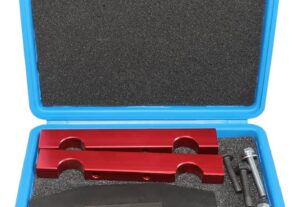Are you tired of dealing with loose or unstable fittings in your assemblies? Look no further than press fit tooling, the solution to achieving perfect fits every time. ️
In this comprehensive guide, we will dive deep into what press fit tooling is, how it works, and its various applications. We’ll also provide tips on how to choose the right tooling for your needs and common mistakes to avoid.
So let’s get started with a brief introduction to press fit tooling.
[h2]What is Press Fit Tooling?[/h2]
Press fit tooling is a precision manufacturing process used to create tight, interference fits between two parts. It involves using a press or other mechanical means to force one part inside another until they lock together with no movement.
The result is a strong and stable joint that can withstand high stresses and loads without loosening or coming apart. This makes it ideal for use in various industries such as aerospace, automotive, medical devices, and electronics.
[h2]How Does Press Fit Tooling Work?[/h2]
The process of press fit tooling involves several steps:
1. Design: The first step in the process is designing the parts to be assembled and determining the tolerances required for a press fit. This includes considering factors such as material type, surface finish, and geometry.
2. Preparation: Before assembly, both parts must be cleaned thoroughly to remove any debris or contaminants that could affect the fit. The parts are then coated with an adhesive or lubricant to aid in insertion.
3. Assembly: Using a press or other mechanical means, the smaller part is inserted into the larger one until it reaches the desired depth. The force required will vary depending on factors such as material type and size.
4. Verification: Once assembled, the fit is verified using various methods such as visual inspection, measurement, or testing. This ensures that the parts are securely locked together and will not come apart under normal use.
[h2]Applications of Press Fit Tooling[/h2]
Press fit tooling has a wide range of applications in various industries. Here are some examples:
1. Aerospace: Press fit tooling is commonly used in aircraft engines, landing gear, and other critical components where high strength and reliability are essential.
2. Automotive: It’s used in engine bearings, suspension systems, brake systems, and other components that require tight tolerances and durability.
3. Medical Devices: Press fit tooling is used in surgical instruments, prosthetics, and other medical devices where precision and safety are paramount.
4. Electronics: It’s used in connectors, circuit boards, and other electronic components to ensure stable connections and prevent damage from vibration or shock.
[h2]Choosing the Right Press Fit Tooling[/h2]
Choosing the right press fit tooling can be challenging, but it’s essential for achieving optimal results. Here are some factors to consider when selecting press fit tooling:
1. Material: The material of the parts being assembled will determine the type of press fit tooling required. For example, soft metals may require a different type of interference fit than hard metals.
2. Surface Finish: The surface finish of the parts should be considered as it affects how easily they can slide together during assembly.
3. Geometry: The shape of the parts being assembled will affect the force required for insertion and the overall fit quality.
4. Tolerance Limits: The tolerances required for a successful press fit should be carefully considered to avoid damaging either part or creating an unstable joint.
[h2]Common Mistakes to Avoid[/h2]
Here are some common mistakes to avoid when using press fit tooling:
1. Failing to Clean Parts: Failure to clean parts before assembly can result in debris or contaminants affecting the fit quality.
2. Using Incorrect Material: Using the wrong material for either part can lead to an unstable joint or damage to one or both parts.
3. Inaccurate Tolerances: Not accurately determining the tolerances required for a press fit can result in a loose or unstable joint.
4. Over-Pressing: Applying too much force during assembly can deform or damage the parts being assembled, leading to an unstable joint.
[h2]Conclusion[/h2]
In conclusion, press fit tooling is an essential process for achieving perfect fits and strong joints in various industries. By understanding how it works, its applications, and how to choose the right tooling, you can achieve optimal results and avoid common mistakes.
If you’re interested in learning more about press fit tooling, be sure to check out our wiki reference below for additional resources.




